Stucco Installation on Block Wall
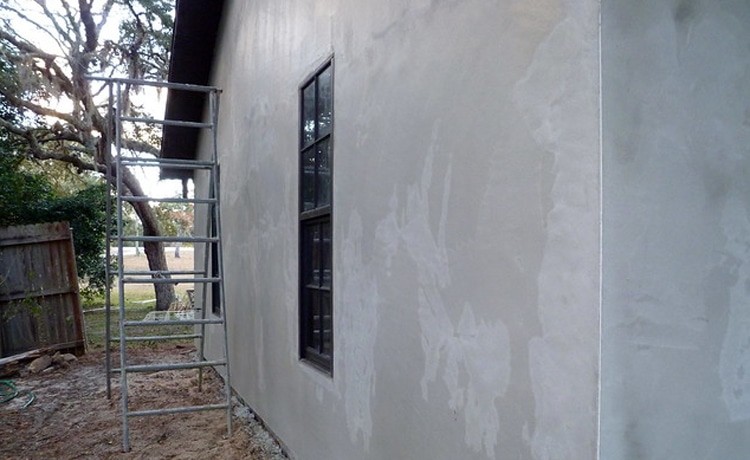
Concrete block makes an exceptional base for Portland cement-based plaster (stucco). The two materials are made from the same basic ingredients and are extremely compatible. Properly done, it’s a great combination.
Concrete block to receive stucco should have an open or coarse texture. This enables the stucco to interlock with the surface of the block providing a mechanical key bond. (Fig. 1)
In some parts of Florida the standard concrete block has a smooth texture. This type of block provides little mechanical bond for the stucco, but may still be considered an excellent base if suction bond can be developed.
Suction bond is the absorption of water and Portland cement from the mortar into the surface of the block. This bond creates a knitting effect at the interface of the stucco and block. (Fig. 2)
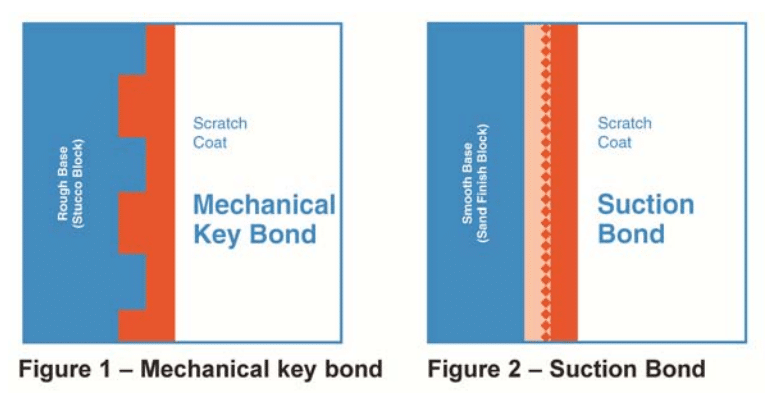
It is a relatively simple procedure to determine if a block wall will provide suction bond. Spray the block with water. If the water is absorbed into the block, suction bond is possible. However, if the water beads up as if on wax paper, suction bond will be negligible. If this condition occurs, the options are to use a dash bond coat, a bonding agent, or if absolutely necessary, a metal plaster base assembly.
Another consideration for suction bond is the absorption rate of the block. A block with a high absorption rate is capable of removing water too rapidly from the stucco mix. Since cement requires water for hydration, this “dry out” removes the necessary ingredient for proper strength gain in the stucco/block interface and good suction bond. This condition also can cause additional shrinkage and cracking. There is, however, a practical solution to this problem. By uniformly wetting the wall (Fig. 3) and waiting for the water to be absorbed prior to the application of stucco, the absorption rate can be controlled and the success of the suction bond can be ensured.
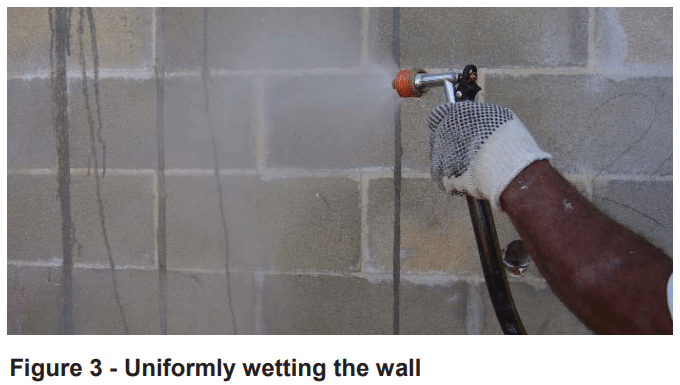
In a block wall that is to receive stucco, the joints are not tooled or struck; instead they are cut flush with the block.
Floating or sponging of mortar joints is prohibited as this practice reduces the mechanical keying required for good bond. The wall should be properly aligned to eliminate large variations in stucco thickness and plane tolerances as define in ACI 530 Chapter 3.
The wall should be inspected for suitability before plastering. The surface should be clean and free of form oil, loose block, efflorescence, mortar drippings, roof tar, etc. Cracks or voids in the mortar joints should be addressed prior to application of stucco.
The Bond
Bond adequacy must be determined before the scratch coat is applied. If a bond problem is suspected, don’t proceed. Consider the other options available:
1) Dash‐Bond Coat – A thick slurry of Portland cement and fine sand plus sufficient water that is dashed by hand or machine onto concrete, masonry, or older plaster surfaces to provide a mechanical bond for succeeding plaster.
2) Bonding Agents – There are several types and variations of these materials. Some are surface applied to the block prior to the application of the scratch coat, while others are integrally mixed into the stucco mortar. It is extremely important that the right bonding agent be used and that it be applied in strict accordance with the manufacturer’s recommendations.
3) Metal Plaster Base Assembly – A paper backed, self‐furring metal lath is recommended for this application and must be adequately anchored to the wall. The purpose for the paper is to make sure that there is a uniform un-bonded condition and that the stucco isn’t adhering to the block in some spots and not in others, a condition which promotes cracking. Where this method is chosen, control and expansion joints and there necessary plaster accessories must be included in the assembly and installed in accordance with ASTM C 1063.
Control Joints
Because stucco and concrete block are similar materials, properly applied and adequately bonded stucco need only be jointed at the control joints in the base wall. This is one of the greatest benefits of using block for a base.
If metal plaster base is used over a block wall, the same recommendations must be followed as with frame construction. Proper spacing of control joints should follow the guidelines established in ASTM C 1063, “Installation of Lathing and Furring for Portland Cement Based Plaster.”

Dissimilar Bases
In walls where block construction abuts another type of construction, the dissimilarity of the bases will cause a crack in the stucco. As a precaution, a control joint is recommended at the juncture of block and frame walls. This will pre‐align and hide the crack in a nice looking joint. (Fig. 4)
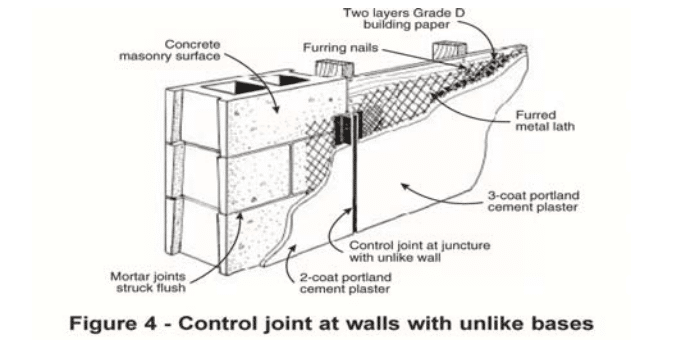
Where concrete and block abut, local experience has shown that placing strip lath over the joint and securing it to the concrete and the block, will minimize cracking. A more conservative design is to install a control joint over the juncture.
The Mix
The stucco mix is characteristic of the aggregates and materials available in each location. An experienced plasterer should know which materials work best and how to proportion them. Always follow manufacturer’s recommendations. The workability of the stucco mix is most important. It must be adhesive enough to stay on the trowel from the hawk to the wall. Plasticity also is needed for ease of troweling and manipulation and at the same time, it must have enough body cohesion to resist sagging. Above all, the mix must bond to the block.
Adequate mixing time is also very critical in achieving proper bond ‐ a minimum of five (5) minutes mixing time after introduction of the final ingredient should be allowed.
Coats And Thickness
For block wall construction, ASTM C 926, “Installation of Portland Cement Based Plaster” contains provisions for either a two‐coat or three‐coat application.
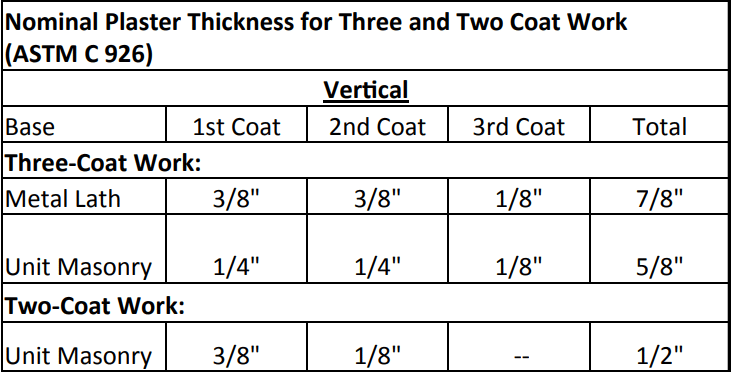
Since a half inch of stucco thickness is sufficient for most block work, the two‐coat, “double‐back” application is recommended. With this method, the scratch coat is allowed to stiffen sufficiently to support the second coat which is then applied. The little or no delay between coats promotes complete curing, less shrinkage and improved bond. (Fig. 5)
In the three‐coat system the bond of the scratch coat to the block must carry the additional thickness and weight of the third coat. This system also has greater potential for shrinkage and cracking. If a three‐coat system is required and there is a question about the bond, or if extra thickness is required, use one of the methods prescribed in the section on Bond above.
The Application
Stucco should be applied with enough pressure to force the material into the surface of the block to ensure a mechanical key and section bond. Just spreading it on the wall may not be sufficient. A slicker should not be used to apply a base coat.
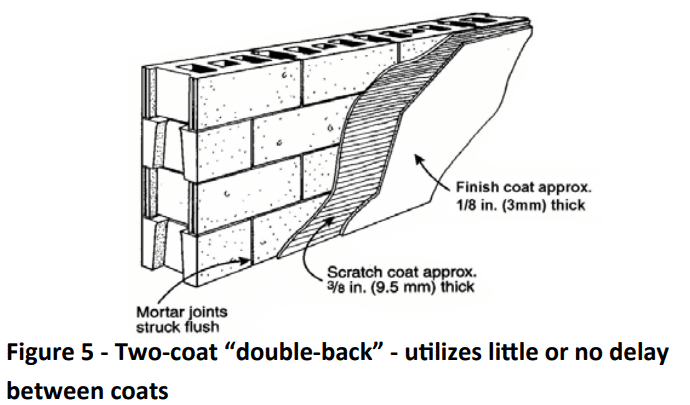
Also, enough material must be applied to obtain the specified thickness of the coat. It may take more than one pass to accomplish this. Adequate thickness is extremely important especially with the scratch coat – since a thin scratch coat is more susceptible to “dry out” and subsequent bond failure.
Curing
Proper curing is essential for the success of a good stucco job. The codes and standards are not very clear about what constitutes good curing. “Sufficient moisture and time between coats” is too vague to be very helpful. In most instances, moist curing such as a fog mist applied several times a day for the first two or three days should be adequate. The stucco should not be allowed to dry out during this period. Additional measures may be required during certain dry or windy seasons in Florida when weather conditions can have a greater impact upon the success of any stucco installation or even stucco repair job.
A Winning Combination
The outcome of a stucco job is dependent on the ability of the construction team to resolve potential problems. A discussion on bond potential and location of control joints between the architect and stucco contractor should be conducted before the job begins. The probability of a successful job will be greatly improved if the stucco contractor is consulted prior to the application of Portland cement plaster.
References
1. ASTM C 926, “Standard Specification for Application of Portland Cement-Based Plaster”, ASTM, 1916 Race St.,
Philadelphia, PA 19103
2. ASTM C 1063, “Standard Specification for Installation of Lathing and furring for Portland Cement-Based Plaster”, ASTM, 1916 Race St., Philadelphia, PA 19103
3. Portland Cement Plaster (Stucco) Manual, EB-049 Portland Cement Association, 5420 Old Orchard Rd., Skokie, IL 60077.
4. “Guide Specifications for Metal Lathing and Furring” Metal Lath/Steel Framing Association, 600 S. Federal Street, Chicago, IL 60605.
NOTE:
Original document was published on www.FLAPB.com and can be read in its entirety here.
Check out this informative video about stucco on block:
If you are looking for stucco installation contractors in Jacksonville FL are contact Stucco Repair Pros for a free stucco installation quote. Call our office at (904) 606-5353 to schedule your appointment. Or just fill out our stucco quote request form on this page.
